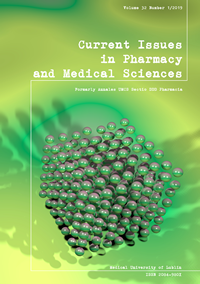Effect of tirapazamine on selected kidney parameters in rats treated with cisplatin
DOI:
https://doi.org/10.2478/cipms-2019-0004Słowa kluczowe:
Cisplatin, Tirapazamine,, NephrotoxicityAbstrakt
Hypoxic cancer cells are more aggressive and responsible for more efficient metastasis and recurrence. It seems worth-while, hence, to supplement current cytostatic drugs therapy (i.e. cisplatin) with hypoxia cytotoxic agents (i.e. tirapazamine), the toxicity of which is activated by hypoxia. Cisplatin and tirapazamine can change a redox equilibrium and consequently lead to changes in cell metabolism, fibrosis and apoptosis. The aim of this study was to evaluate the cisplatin/tirapazamine toxicological synergism. In doing so we tested selected kidney oxidative stress parameters, as well as nephrotoxicity markers, in plasma and urine. Once a week for 6 weeks, rats received intraperitoneally two doses of tirapazamine (5 or 10 mg/kg bw), 2 hours before cisplatin (2 mg/kg bw) was applied. Our results show that Tirapazamine (TP) had no significant adverse effect on the redox balance, oxidative stress and kidney function in rats receiving cisplatin (CP). However, TP significantly increased protein concentration in the kidneys of rats. In all tested groups, a significant decrease in NADH concentration in kidneys was recorded, which could indicate disorder in the cell metabolism. TP also was found to have prevented bacterial infection caused by CP. In summary, there was no nephrotoxic synergy of TP with CP at an unacceptable level.Bibliografia
1. Tredan O, Galmarini CM, Patel K, Tannock IF. Drug resistance and the solid tumor microenvironment. J Natl Cancer Inst. 2007;99: 1441-54.
2. Kyle AH, Minchinton AI. Measurement of delivery and metabolism of tirapazamine to tumour tissue using the multilayered cell culture model. Cancer Chemother Pharmacol. 1999;43:213-20.
3. Rischin D, Peters L, Fisher R. Tirapazamine, cisplatin, and radiation versus fluorouracil, cisplatin, and radiation in patients with locally advanced head and neck cancer: a randomized phase II trial of the Trans-Tasman Radiation Oncology Group (TROG 98.02). J Clin Oncol. 2005;23:79-87.
4. Hicks KO, Myint H, Patterson AV, Pruijn FB, Siim BG, Patel K, Wilson WR. Oxygen dependence and extravascular transport of hypoxia-activated prodrugs: Comparison of the dinitrobenzamide mustard PR-104A and tirapazamine. Int J Radiat Oncol Biol Phys. 2007;69:560-71.
5. Marcu L, Olver I. Tirapazamine: from bench to clinical trials. Curr Clin Pharmacol. 2006;1:71-9.
6. Rischin D, Peters LJ, O’Sullivan B. Tirapazamine, cisplatin, and radiation versus cisplatin and radiation for advanced squamous cell carcinoma of the head and neck (TROG 02.02, HeadSTART): a phase III trial of the Trans-Tasman Radiation Oncology Group. J Clin Oncol. 2010;28:2989-95.
7. Di Silvestro PA, Ali S, Craighead PS. Phase III randomized trial of weekly cisplatin and irradiation versus cisplatin and tirapazamine and irradiation in stages IB2, IIA, IIB, IIIB, and IVA cervical carcinoma limited to the pelvis: a Gynecologic Oncology Group study. J Clin Oncol. 2014;32:458-64.
8. Chen HHW, Kuo MT. Role of Glutathione in the Regulation of Cisplatin Resistance in Cancer Chemotherapy. Metal-Based Drugs. 2010;2010:430939.
9. Ozkan TA, Aydin U, Ay D, Cebeci IOO. Cisplatin and bleomycin-induced acute peripheral-vascular stenosis in patient with testicular cancer. Urology Annals. 2016;8:483-5.
10. Qian X, Ma C, Hoffmann TK, Kaufmann AM, Albers AE. Taxane-cisplatin-fluorouracil as induction chemotherapy for advanced head and neck cancer: a meta-analysis of the 5-year efficacy and safety. SpringerPlus. 2015;4:208.
11. Dasari S, Tchounwou PB. Cisplatin in cancer therapy: molecular mechanisms of action. Eur J Pharmacol. 2014;740:364-78.
12. Miller RP, Tadagavadi RK, Ramesh G, Reeves WB. Mechanisms of Cisplatin Nephrotoxicity. Toxins. 2010;2:2490-518.
13. Arany I, Safirstein RL. Cisplatin nephrotoxicity. Semin. Nephrol. 2003;23:460-4.
14. Guise CP, Mowday AM, Ashoorzadeh A. Bioreductive prodrugs as cancer therapeutics: targeting tumor hypoxia. Chinese Journal of Cancer. 2014;33(2):80-6.
15. Rades D, Seidl D, Janssen S, Strojan P, Karner K, Bajrovic A, Hakim SG. Comparing two lower-dose cisplatin programs for radio-chemotherapy of locally advanced head-and-neck cancers. European Archives of Oto-Rhino-Laryngology. 2017;1:1-7.
16. Rabik C, Fishel M, Holleran J, Kasza K, Kelley M, Egorin M, Dolan M. Enhancement of cisplatin cytotoxicity by O6-benzylguanine involves endoplasmic reticulum stress. J. Pharmacol. Exp. Ther. 2008;327:442-52.
17. Santos NA, Catao CS, Martins NM, Curti C, Bianchi ML, Santos AC. Cisplatin-induced nephrotoxicity is associated with oxidative stress, redox state unbalance, impairment of energetic metabolism and apoptosis in rat kidney mitochondria. Arch Toxicol. 2007;81(7): 495-504.
18. Kadikoylu G, Bolaman Z, Demir S, Balkaya M, Akalin N, Enli Y. The effects of desferrioxamine on cisplatin-induced lipid peroxidation and the activities of antioxidant enzymes in rat kidneys. Hum Exp Toxicol. 2004;23:29-34.
19. Delahoussaye YM, Evans JW, Brown JM. Metabolism of tirapazamine by multiple reductases in the nucleus. Biochem Pharmacol. 2001;62(9):1201-9.
Pobrania
Opublikowane
Numer
Dział
Licencja
Prawa autorskie (c) 2019 Autorzy

Praca jest udostępniana na licencji Creative Commons Attribution-NonCommercial-NoDerivatives 3.0 Unported License.


